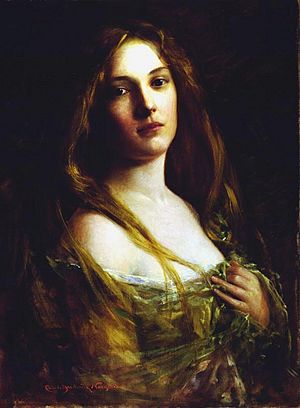Gentile Budrioli facts for kids
Gentile Budrioli (died July 14, 1498) was an Italian astrologer and herbal healer. She lived in Bologna in the late 1400s. Gentile studied at the University of Bologna and learned from Franciscan monks. People noticed her great skill in healing. She became a close friend of Ginevra Sforza, whose husband, Giovanni II Bentivoglio, ruled Bologna. Because of this friendship, Gentile quickly became important in the city. She even worked as an advisor at the Bolognese court for a short time.
Gentile's growing importance made some people jealous. In 1498, she was accused of witchcraft. This happened after she could not save one of Bentivoglio's sons from an illness. Her case was handled by the Inquisition, a powerful church court. They made up evidence against her. At her trial, many people said she was a witch. Even her own husband, Alessandro, who did not like her scientific interests, spoke against her. Gentile Budrioli was executed in front of a crowd in the Piazza San Domenico in Bologna.
Contents
Gentile's Early Life
Gentile Budrioli was born into a rich noble family in Bologna. From a young age, she was different and very interested in science.
Gentile married a wealthy notary named Alessandro Cimieri. He owned a house near the Basilica of Saint Francis in Bologna. Her father arranged the marriage because Alessandro was from a good family. Her father might have hoped Alessandro would make Gentile less interested in her studies. Gentile and Alessandro had seven children: three daughters and four sons.
Education and Rise to Power
Gentile Budrioli was a rich, smart, and beautiful woman. She found her married life with Alessandro boring. She kept her strong interest in science, even though her husband did not like it. Gentile went to lessons at the University of Bologna. She especially liked the astrology classes taught by Professor Scipione Manfredi. When her husband found out, he stopped her from going to these lessons.
Besides university studies, Gentile also learned from a Franciscan monk named Silvestro. He lived at a Franciscan convent near her home. From him, she learned about herbal healing. For a while, Gentile reportedly met with Silvestro every day to learn.
Over time, Gentile became very skilled in medicine. Many people thought she was better than the professional doctors in Bologna. She helped other city residents with their health problems, both physical and mental. One of her most important patients was Ginevra Sforza. Ginevra was the wife of Giovanni II Bentivoglio, the ruler of Bologna. Ginevra first asked Gentile for help with pains after childbirth.
The two women quickly became close friends. They shared an interest in mystical knowledge. Gentile and Ginevra often spent whole afternoons talking and reading together. Gentile's skills and her friendship with Ginevra helped her become important in the city. Soon, she was made an advisor at Bentivoglio's court.
Accused of Witchcraft
Gentile was a smart woman who openly shared her knowledge and influence. Because of this, some noble families in Bologna looked at her with suspicion. Her quick rise to power also made others in the city jealous.
Gentile tried her best for several days to save one of Bentivoglio's sons who was very sick. But she could not. The Malvezzi family, who were rivals of the Bentivoglios, used this chance. They claimed that Gentile had actually caused the child's illness through witchcraft. She was also accused of being behind other bad events in the city. It is possible these accusations were a way to attack Ginevra Sforza, who was too powerful to be attacked directly. Accusations of witchcraft were common then. They happened because of superstition, political reasons, and even money. If someone was executed for witchcraft, their belongings were taken and split between the church and the local government.
The Trial
Bentivoglio reportedly believed the accusations. Gentile Budrioli was arrested right away. Executing Gentile as a witch might have been a plan for Bentivoglio to improve his relationship with Pope Alexander VI. The Pope was threatening to take control of Bologna. Ginevra Sforza did not defend her friend. Perhaps she feared she would also be punished if she did.
Gentile's case was handled by the Inquisition. This court was often very harsh towards women accused of witchcraft. The local Inquisition had reportedly watched her for some time, waiting for her to make a mistake. Soon after Gentile was put in prison, the Inquisition judges searched her home. They "found evidence" of witchcraft. This included traces of blood, different cloaks, small bottles with liquids, and an altar.
After the search, Gentile Budrioli was formally put on trial. Many witnesses came forward to say she was a witch. Gentile was interested in both astrology and healing herbs. This made it easy to convince the townspeople she was guilty. Even Alessandro Cimieri, Gentile's own husband, accused her of witchcraft. He claimed she had cast a spell on him that hurt his mind. Some witnesses also said she had cast spells on her brother Ercole. Others claimed Gentile could predict the future by looking at the stars.
Execution
On the morning of July 14, 1498, Gentile Budrioli was taken to the Piazza San Domenico. This was right across from her home. She was executed in public.
Ginevra Sforza did not go to the execution. She was reportedly at Gentile's house at the time, weeping. After the execution, Ginevra took care of Gentile's daughters. She arranged good marriages for some and placed others in convents.
Legacy
The Italian historian Leandro Alberti (1479–1552) wrote about Gentile Budrioli's story. He dedicated two pages of his history of Bologna to her. Gentile is still remembered today as the "great witch of Bologna." In 2018, the Italian writer Barbara Baraldi mentioned Gentile. She said Gentile was one of many women in history who paid a high price for being ahead of their time. In 2011, a musical was created about the friendship between Gentile Budrioli and Ginevra Sforza. It was called Ginevra e Gentile ("Ginevra and Gentile").


